California has been a clear leader in deployment of solar and other forms of renewable energy. While it has not reached the very high portions of wind that smaller Plains States have boasted, the The Golden State has been a leader in terms of raw deployment, backed by renewable energy mandates for utilities as well as policies to support residential solar and battery deployment.
And those policies are paying off. A new report by non-profit Next 10 not only confirms what the state’s renewable portfolio standard updates have shown, that it is rapidly decarbonizing the electricity sector.
Solar has played a leading role here. Next 10 states that in 2017 solar overcame wind as the state’s largest renewable power source, representing 10% of its total mix. pv magazine’s calculation of raw data provided by the U.S. Department of Energy shows that solar – both large-scale and behind-the-meter – rose to meet 14% of all in-state demand in 2018, however it is not clear if we are using the same methodology.
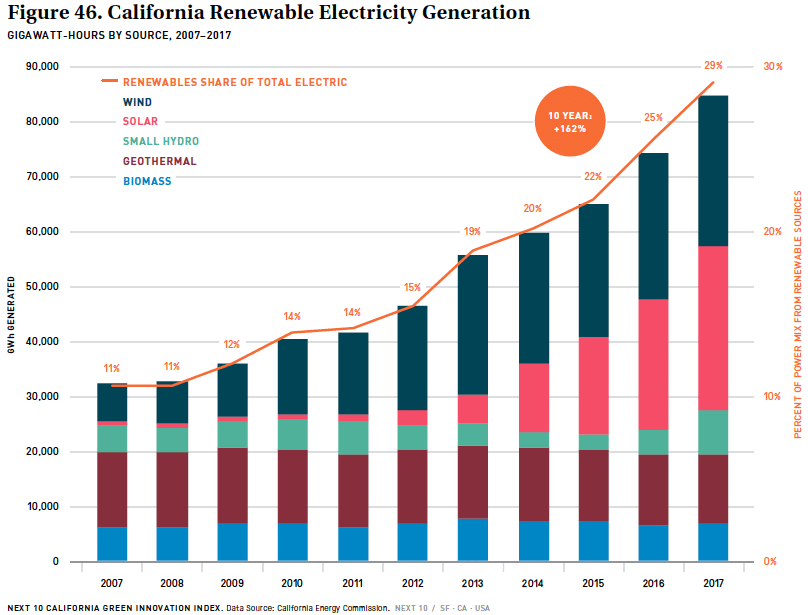
Either way, solar largely drove total in-state renewable energy growth rates of over 20% from 2013 through 2017, and a stunning 162% increase in renewable energy output over a 10-year period. This has led Next 10 to conclude that at current growth rates California is set to meet its ambitious targets for RPS-compliant renewables to represent 50% of electricity generation in 2026 and 60% in 2030, “with relative ease”.
Battery deployment is also on schedule. California easily the nation’s largest energy storage market, and the roughly 1.5 GW of energy storage to be procured by the state’s large investor-owned utilities is above the 1.325 GW requirement set by AB 2514.
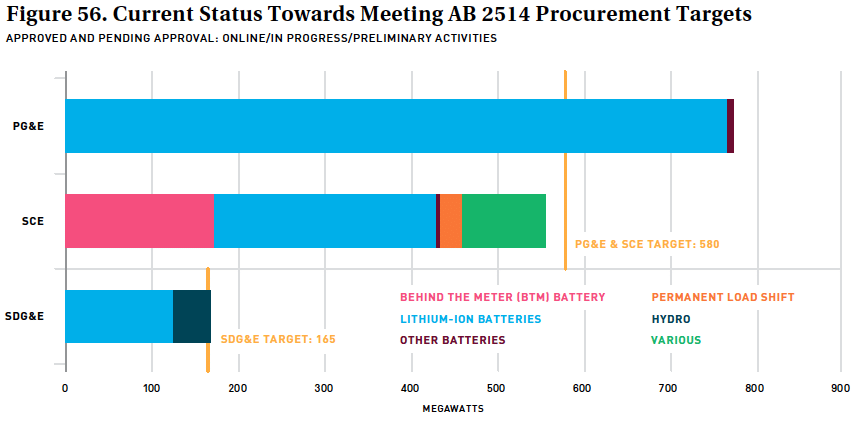
Some of the optimism for the future can come from California’s Community Choice Aggregators, which are taking over procurement for an increasing portion of the state’s electric load from investor-owned utilities under mandates to decarbonize faster than is required by state law.
Cars
That is the good news. The bad news is that even with this progress in the electricity sector, Next 10 says that given current rates of decarbonization California is not on track to meet its 2030 or 2050 goals for greenhouse gas reductions.
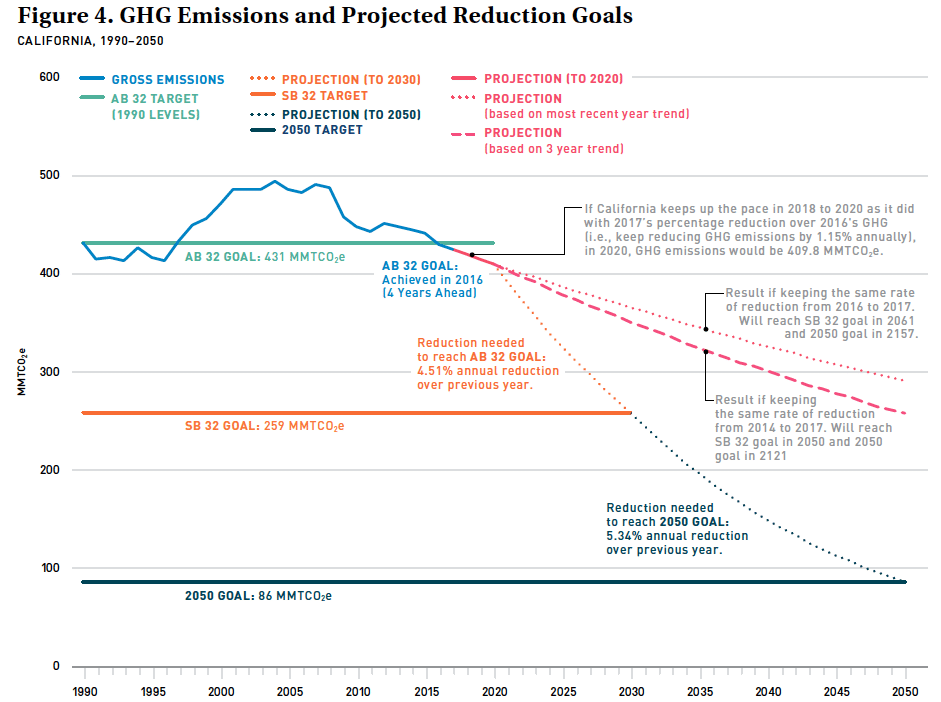
And while the report looks at many sectors, one problem stands out as obvious: cars. The transportation sector alone represents 41% of California’s emissions, with passenger vehicles making up the bulk of that. In 2017 the state saw both a record number of vehicles registered at 31 million and also a record number of vehicle miles travelled. This has been accompanied by falling participation in public transit ridership, amid a new boom in ridesharing services.
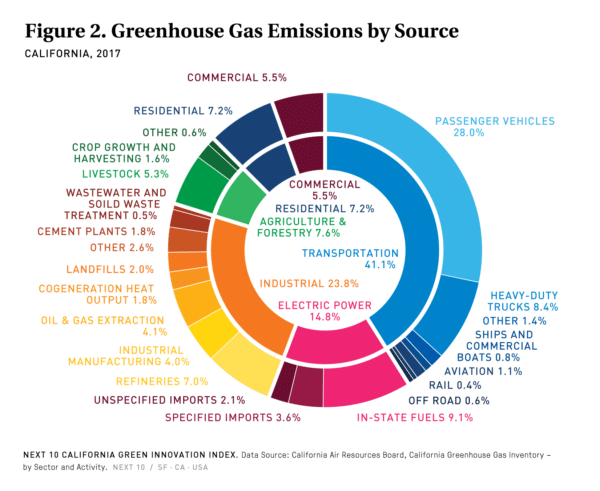 The net result is that despite nationally leading fuel efficiency standards, greenhouse gas emissions from the transportation sector continue to rise. Nor have electric vehicles (EVs) yet made much of a dent. California has a higher rate of EV sales than the national average, but hybrids and EVs still make up a small portion of the total vehicles on the road.
The net result is that despite nationally leading fuel efficiency standards, greenhouse gas emissions from the transportation sector continue to rise. Nor have electric vehicles (EVs) yet made much of a dent. California has a higher rate of EV sales than the national average, but hybrids and EVs still make up a small portion of the total vehicles on the road.
One challenge is that automobiles don’t turn over every year, but can stay on the road a decade or longer, meaning that emissions from cars sold today are locked in for many years to come. And this leads to debate over the path forward. While some are calling for a more rapid electrification of automobiles, the California Air Resources Board and others have framed the problem in terms of a need to reduce vehicle miles travelled.
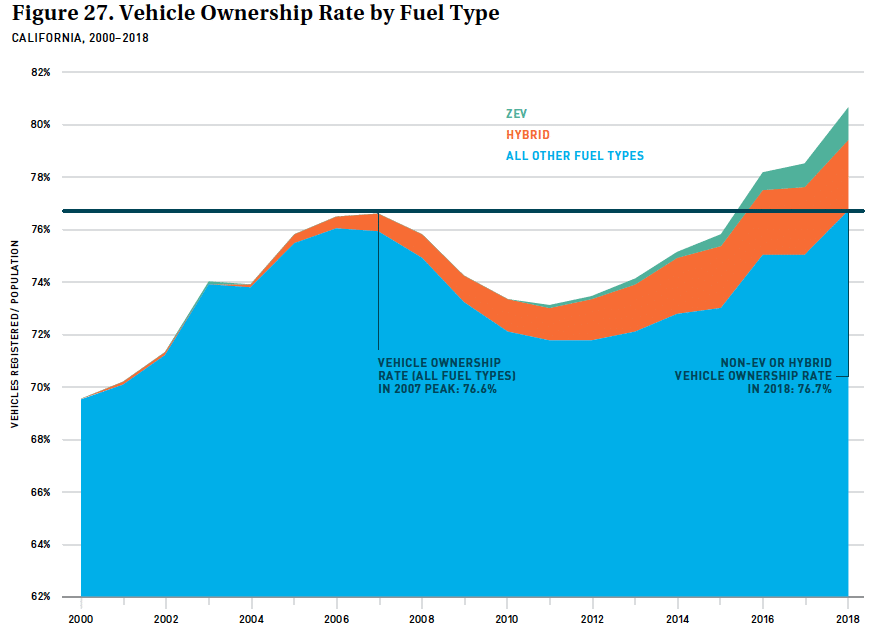
The solution is likely to be a combination of both. Either way, the report serves as a stark warning that for deep emissions reductions, decarbonizing electricity is only the beginning.
This content is protected by copyright and may not be reused. If you want to cooperate with us and would like to reuse some of our content, please contact: editors@pv-magazine.com.
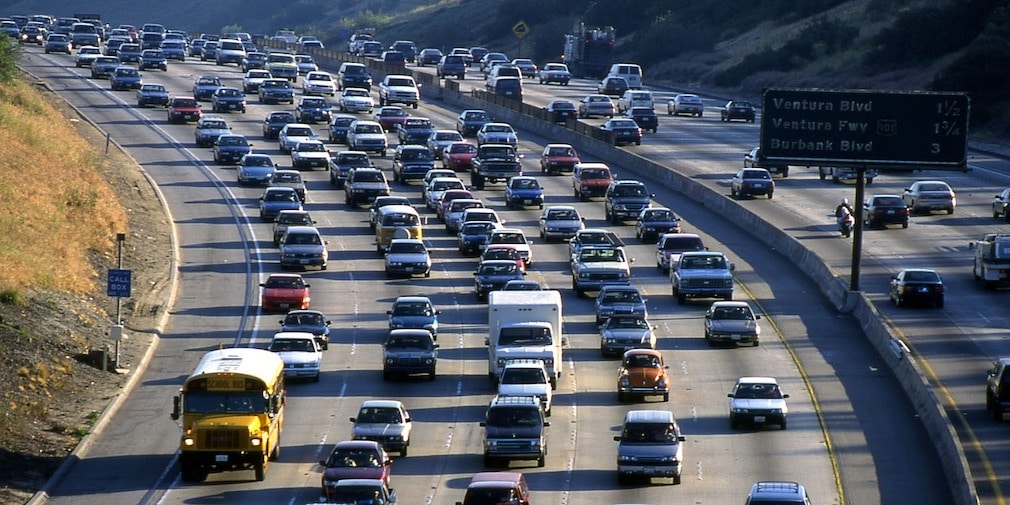








Twelve 300w solar panels will produce an average of 50 miles of pure EV range daily everywhere in the US. Emissions = zero! The average car travels 37 miles/day.
Yes – as stated in the article, the challenge of reducing transportation emissions rapidly with EVs is electrifying quickly enough given the typical lifetime of used vehicles. We need to not only get EVs on the road to replace new cars, but all the used cars out there as well. And that will take time.
The key word is ‘on average’. The unfortunate reality is that those rooftop solar panels produce half as much in winter, and the cars need twice as much.
Storage of enough heat from summer to last the winter is a solved problem (i.e. Drake Landing Solar Community) but electricity storage is not.
For anyone with access to full net metering, it’s someone *else’s* problem, but things have a way of not staying the same.
Hello Randy,
That’s an interesting mix of myth and statements that are more or less accurate but lack critical context and become misleading.
Cars – EV or ICE – don’t need 2x the energy in winter, and particularly not in the mild winters that happen in most of California.
According to the latest data from EIA, PV in California did generate around 1/2 as much during winter months in 2017 as during summer. But there is no need to have seasonal storage when you have this thing called transmission lines. California already imports much of its power, and in a very high renewable energy scenario will need to bring in a lot of power from outside the state during the winter. This could be from wind in the Mountain West, or hydro in the Northwest. Additionally California has hydro that will meet some of the generation shortfall from solar in the winter.
As for net metering, small-scale PV currently is only 1/3 of the solar deployed.
– Christian
My comment was in response to the ‘everywhere in the US’ comment above, rather than the article so not strictly referring to California. 12 x 300w perfectly positioned would deliver 3600 w peak, 50 miles x 250 wh x365 days is 1267 annual wh/wp
My experience is at 51 degrees north latitude, a bit north of 49, with 10,240 w peak has been: A sunny day in June = 75 KWh / 300 miles vs sunny day in October 45 KWh / 180 miles, but a stormy day last week was just 2 KWh / 8 miles.
Certainly in California you wouldn’t ever see 40 or 50% range loss from heater use or slushy roads, or a Tesla battery too cold to charge at all. But we have, and I don’t think winters are that much different on the high plains of northern Montana, Wyoming, or North Dakota.
Sure, as long as there is a neighboring state with a low carbon surplus at the right time, California wil be fine.
Without full net metering, I would go bigger still on the solar array to minimize grid draw and charge faster.
“Battery deployment is also on schedule. California easily the nation’s largest energy storage market, and the roughly 1.5 GW of energy storage to be procured by the state’s large investor-owned utilities is above the 1.325 GW requirement set by AB 2514.”
When Diablo Canyon nuclear plant’s approximately 2GW of baseload power is gone sometime between 2023 to 2025, all of the imported power that will need to be sent along from other States to keep the California night time grid up will become onerous. This proposed 1.5GW of energy storage may not be enough. If CAISO keeps contracting with out of State power generators while “curtailing” solar PV and wind generation while energy is practically free, then this has become just another experiment in feel good foolishness. For the air conditioning demands of Southern California alone, one would need about all of that 1.5GW of storage to keep the grid stable at night time. Northern California’s “air conditioning load” demands wouldn’t be as severe and yet there’s still a need for at least that much energy storage again. Let’s look historically at what California has lost or never had. In 1976 Jerry Brown with the stroke of a pen killed what would have been a 2GW nuclear plant, Sundesert Nuclear Plant near Blythe California. SONGS failed due to corrosion damage and was shut down. Another 2GW of baseload gone. Diablo Canyon soon another 2GW baseload gone. 6GW of baseload not available. As the march of more utility scale solar PV and wind generation is installed in California over the next decade, there will be a need for much more energy storage. CAISO cannot keep “curtailing” alternative energy during the day and buying peak demand fueled generation at night. This would be insanity. Depending on who’s statistics one uses, California needs about another 170GW of generation to get to “decarbonization” of the grid. At “just” 25% energy storage there needs to be 50GW available. With wild fires and storm systems slamming into the State, sometimes for days, it might be smart to have double the energy storage or 100GW of distributed energy storage.
You often submit long comments that are not fully backed by evidence or fact, but this one really takes the cake.
2 GW is a small fraction of California’s overall generation fleet, and you haven’t supplied any real evidence of your claim that “all of the imported power that will need to be sent along from other states to keep the California night time grid up will become onerous”.
The 1.5 GW of energy storage is simply not all that is supplying power overnight. California also has wind, and when that is not blowing, it has an enormous fleet of natural gas-fired power plants and hydro plants – before we even get into the substantial ability to import large volumes of electricity.
And per your claim that the deployment of solar has been “feel-good foolishness”, there are two things to consider. 1) on an annual basis the amount of solar and wind that are curtailed are a small fraction of overall generation. 2) The deployment of solar and wind has coincided with substantial reductions in greenhouse gas emissions each year. This is well documented:
http://www.caiso.com/Documents/GreenhouseGasEmissions-TrackingReport-Aug2019.pdf
I could go on, but you have taken enough of my time and our readers’ time with spurious, unsupported claims.
How about incentivizing ride share providers to increase their use of EVs. A ride share EV could have it’s capacity factor increased over the average car by from 5x to 10x. This would take fossil driven miles off the road more quickly than waiting for everyone to buy an EV. It could be as simple as adding to the deductibility of EV miles driven.